The Worst Is Yet to Come for the Stock Market. So Is a Swift Snapback.

Traders at the New York Stock Exchange on Monday, Feb. 28.
Michael Nagle/Bloomberg
It’s the end of the world as we know it. The stock market, however, isn’t going anywhere.
The last full trading week of February ended with optimism that Russia’s invasion of Ukraine would end quickly and not become a global issue. How wrong we were. The scenes out of Ukraine have been devastating, and while resistance has been stiff, Russia’s tactics have gotten more extreme. Europe has rallied together in response, but sanctions don’t look like they will bring a speedy end to the war.
No wonder, then, that the stock market had a tough week. The Dow Jones Industrial Average shed 1.3%, its fourth week of losses in a row, while the S&P 500 also shed 1.3% and the Nasdaq Composite fell 2.8%.
In moments like these, it’s easy to feel despondent, both for the state of the world and the market. And it does feel like the worst is still to come. Russia’s Vladimir Putin shows no signs of letting up, despite facing devastating measures that could wreck the Russian economy. Oil prices are spiking, inflation is surging, and the Federal Reserve is set to start hiking rates.
It’s enough to make one head for the safety of cash and even make Brazil look like an attractive destination for investment dollars.
But there’s a big difference between a correction and a full-fledged bear market, which is usually accompanied by a recession—and the U.S. economy may be sturdier than many expect. Take oil prices. With West Texas Intermediate crude, the U.S. benchmark, surging past $110 a barrel and more gains in sight, many observers have pointed to the fact that higher oil prices have often preceded recessions. But that wasn’t the case in 1987, 1996, 2011, or 2018, when oil spiked but recessions didn’t occur, observes MKM Partners Chief Economist Michael Darda.
More important, monetary policy is still easy—and will continue to be so for a while—which should allow the economy to absorb the pain that comes from higher crude prices. “Oil price spikes that are monetized by an accommodative monetary backdrop will raise the price level but the recession comes only after monetary policy becomes restrictive and we are a long way from such an eventuality,” Darda writes.
And the U.S. economy does seem to be holding up, at least for now. Retail stocks like Kohl’s (ticker: KSS) and Nordstrom (JWN) soared this past week after reporting better-than-expected earnings and strong guidance. February’s payrolls report also showed an economy that appeared to have moved past Covid, as jobs in leisure and hospitality, healthcare, and construction returned. Even better: Just 4.2 million people said they couldn’t work because their employer had issues with Covid, down from six million in January.
If the U.S. economy proves resilient once again, the current decline could end up being remembered as just another “growth scare,” says Lori Calvasina, head of U.S. equity strategy at RBC Capital Markets. There have been four such scares since the financial crisis, in 2010, 2011, 2015, and 2018. They lasted 147 days, on average, with a median decline of 17.3% for the S&P 500. That suggests there’s more downside ahead, but the rebounds from those drops have been quick and long-lasting, with stocks up 6.5% over the first five days after a bottom, and 24% over the following six months.
“It’s like a springboard coming out,” she says. “We might not have seen the full downside, but recoveries tend to move fast.”
When they finally come.
Write to Ben Levisohn at [email protected]




